Physical Address
304 North Cardinal St.
Dorchester Center, MA 02124
Physical Address
304 North Cardinal St.
Dorchester Center, MA 02124
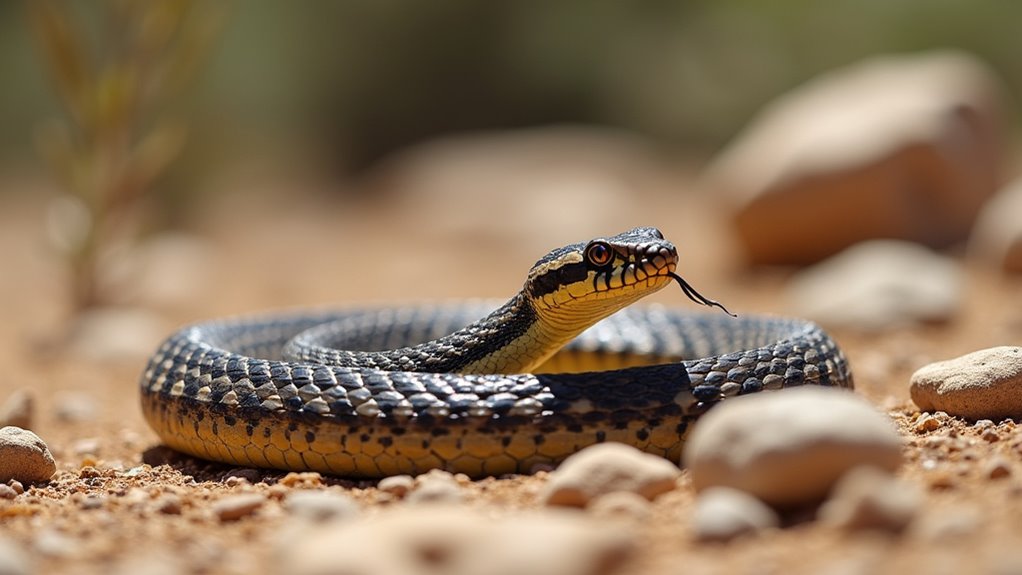
Curious about Texas's seven deadly serpents? Learn to identify these venomous snakes before your next outdoor adventure begins.
Isn’t it strange that just as you’re planning that Texas hiking trip, venomous snake season reaches its peak? While the Lone Star State offers breathtaking outdoor adventures, it’s also home to seven potentially deadly serpent species that demand your respect and caution. From the Western Diamondback’s distinctive rattle to the Coral Snake’s deceptively beautiful bands, knowing which snakes pose threats—and how to avoid dangerous encounters—could literally save your life in Texas’s diverse landscapes. What’s hiding in that tall grass ahead?
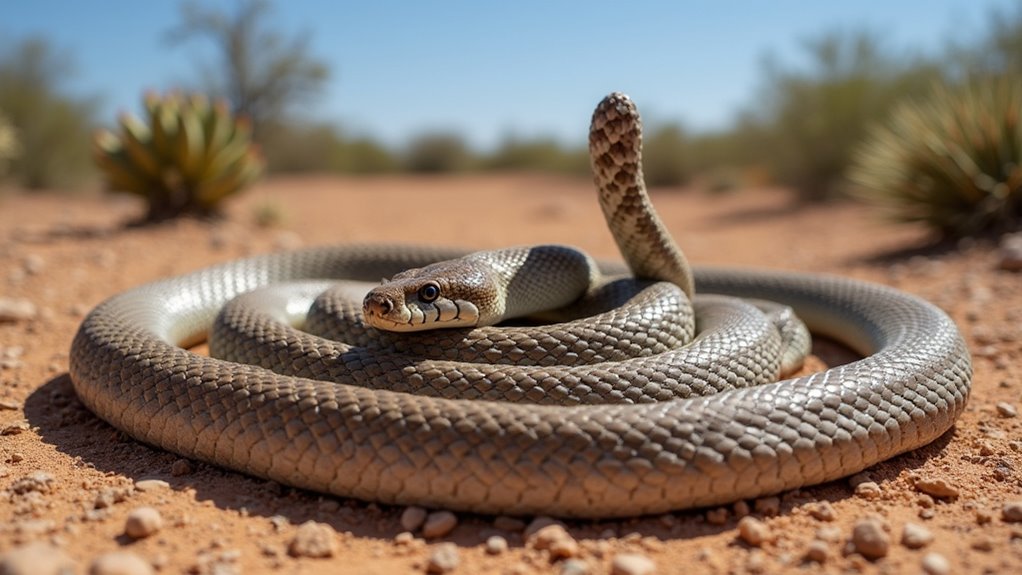
Among Texas’s venomous serpents, the Western Diamondback stands as the state’s most notorious rattlesnake. You’ll find this deadly reptile throughout Texas except in the northern panhandle and dense eastern forests. It thrives in deserts, grasslands, and rocky hillsides.
These snakes hunt primarily at night during hot months but switch to daytime activity in cooler weather. They’re ambush predators, striking mammals with hemotoxic venom that destroys tissue and prevents blood clotting. With an average venom yield of 250-350 mg per bite, the Western Diamondback possesses enough toxin to deliver potentially fatal doses. Unlike non-venomous snakes found in other states like Ohio, Western Diamondbacks present a serious medical emergency when encountered.
When temperatures drop, they’ll hibernate in rock crevices or abandoned rodent burrows.
If you’re exploring Texas’s arid regions, listen for their distinctive buzz—a warning before they strike. Though fatality rates are below 1% with proper treatment, their bites account for most serious snakebite incidents in Texas.
While the Western Diamondback might dominate Texas’s desert regions, the Cottonmouth rules the state’s wetlands with equally dangerous authority. You’ll find these semi-aquatic predators throughout east Texas, around Dallas/Fort Worth, and parts of the Hill Country. They prefer slow-moving water bodies where they hunt with deadly efficiency. The scientific name Agkistrodon piscivorus reflects this snake’s fish-eating tendencies in aquatic environments. Unlike most spiders in Florida, Cottonmouths are aggressive when threatened and will stand their ground rather than flee.
When threatened, they’ll display their namesake white mouth—a clear warning you shouldn’t ignore. Though fatalities are rare, their hemotoxic venom causes severe tissue damage requiring immediate medical attention.
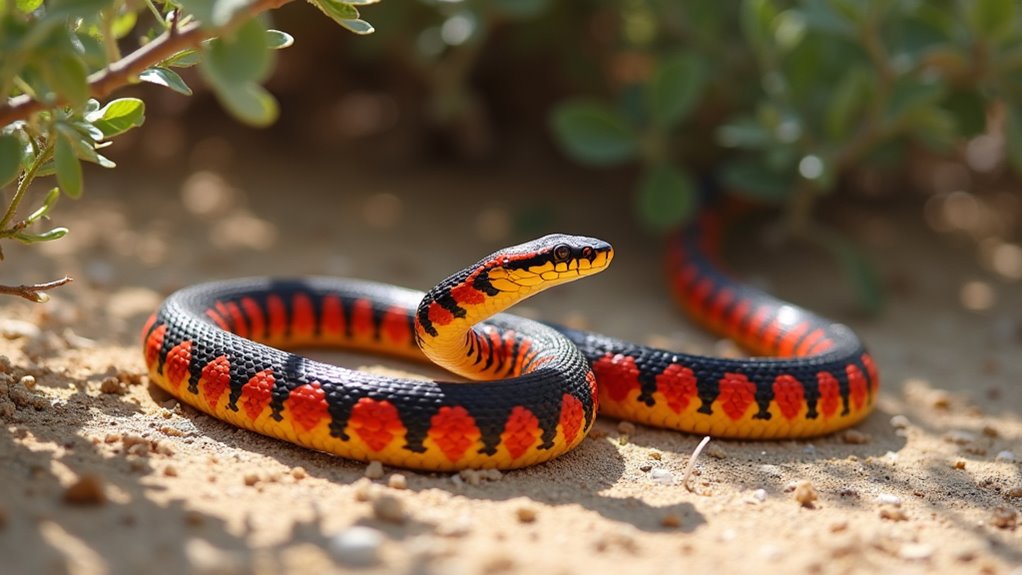
Unlike rattlesnakes, coral snakes have round heads and grow 20-30 inches long.
Their potent neurotoxin can cause respiratory failure, but symptoms mightn’t appear for hours after a bite.
You’re most likely to encounter them after rain or in areas with dense ground cover.
After rainfall or in thick vegetation, coral snakes emerge from hiding, increasing your chances of an unexpected encounter.
They’re active during daylight in cooler months but become nocturnal in summer.
Remember the rhyme “red touch yellow, kill a fellow” to identify these colorful venomous snakes with distinctive black, yellow, and red rings.
Unlike the amazing snakes of Puerto Rico’s ecosystem, Texas coral snakes are native to the continental United States.
If you spot a coral snake, keep your distance.
While they cause less than 1% of U.S. snakebites, their venom requires immediate medical attention if you’re bitten.
The copperhead’s masterful camouflage makes it one of Texas’ most dangerous snakes, despite rarely causing fatalities. Found throughout the eastern third of the state and in western Texas riparian zones, these snakes blend perfectly with forest leaf litter.
You’ll recognize them by their distinctive hourglass-shaped chestnut bands on a lighter tan body.
While mainly active at night during summer, copperheads change to diurnal habits in spring and fall months.
When visiting areas like Sanibel Island where wildlife encounters are possible, remember that proper outdoor awareness can help you avoid snake encounters altogether.
If bitten, seek medical attention immediately—their hemotoxic venom causes tissue damage and requires antivenom treatment.
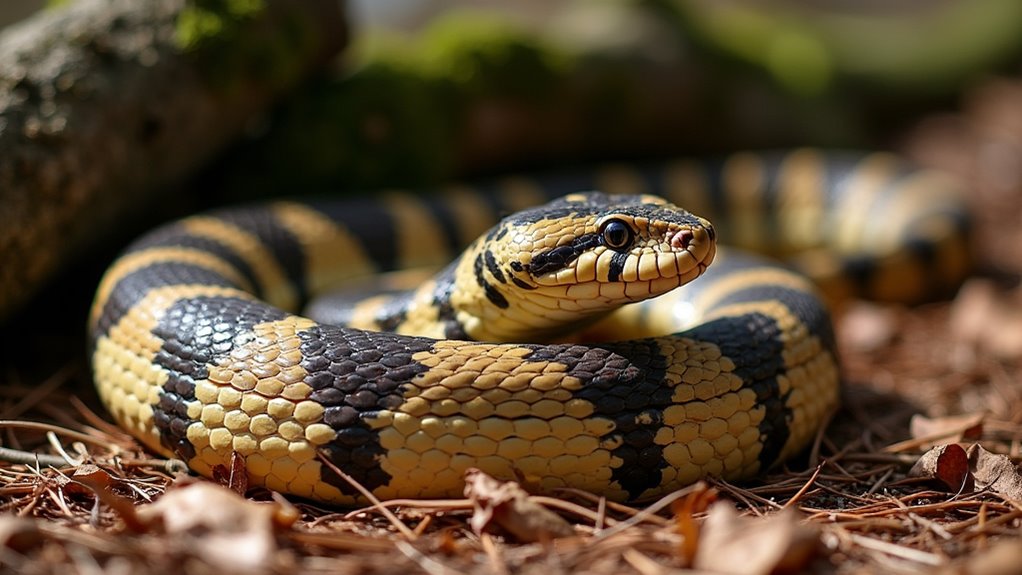
Where dense vegetation meets water in eastern Texas, you’ll encounter one of the state’s most impressive venomous snakes—the timber rattlesnake. These threatened reptiles prefer habitats with rocky outcrops and permanent waterways, making their homes in floodplains and upland forests.
You’ll find timber rattlesnakes most active when temperatures range between 50-85°F. They’re primarily diurnal during spring and fall but hibernate communally from October through April, often sharing dens with copperheads and racers.
As keystone predators controlling rodent populations, timber rattlesnakes play a vital ecological role. Their presence indicates healthy, intact ecosystems. These impressive predators use a sit-and-wait strategy, positioning themselves near rodent pathways to ambush prey.
If you’re exploring eastern Texas woodlands, watch for these protected snakes—they’re federally threatened and subject to conservation regulations due to habitat fragmentation and development pressures.
Sweeping across the vast grasslands of western and central Texas, prairie rattlesnakes stand as vigilant guardians of the state’s open landscapes. You’ll find these adaptable serpents in diverse environments, from low-lying desert scrub to elevated foothills up to 2,700 feet. Their distinctive diamond-patterned bodies blend with brown or greenish hues, camouflaging them perfectly against their surroundings. These impressive reptiles can grow to over 100 cm in length, making them a formidable predator in their ecosystem.
During summer hikes, watch for them near rocky outcroppings where they bask in the Texas sun. While planning a trip through Texas, consider that these snakes are most active during the warmer months similar to when travelers enjoy epic road trips along the western coast.
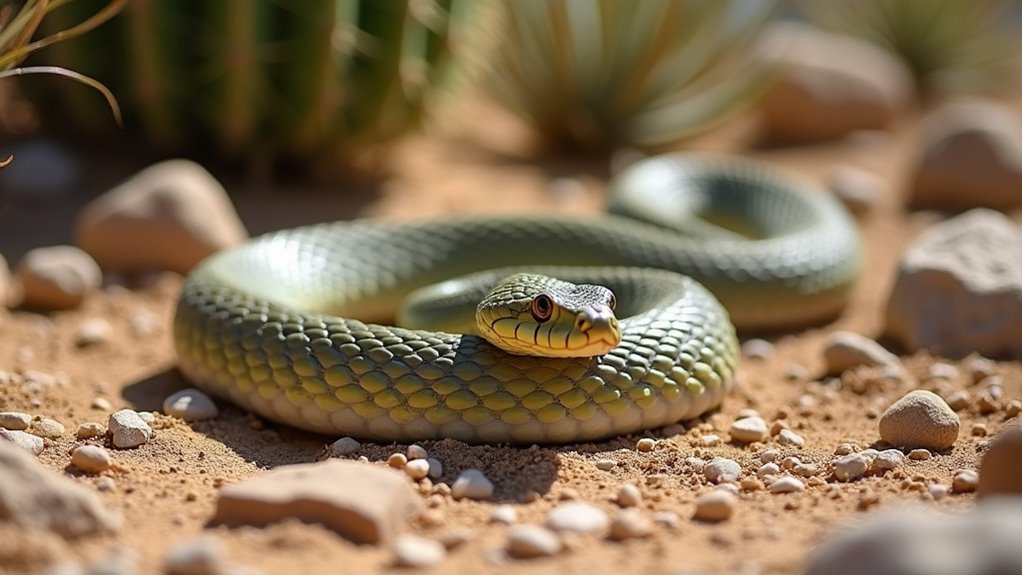
Lurking beneath the sparse creosote and mesquite of western Texas, the Mojave rattlesnake commands respect as one of North America’s most dangerous serpents.
You’ll find this medium-sized rattler (3-4 feet) primarily in the Big Bend region and Trans-Pecos area, where it thrives in open desert terrain up to 2,500m elevation. While less common in Oklahoma, the Mojave is among the dangerous animals that populate the southwestern United States.
What makes this greenish-gray serpent particularly treacherous is its potent neurotoxic-hemotoxic venom. Some populations carry what’s known as Venom A, containing the Mojave toxin, while others produce Venom B which lacks this neurotoxin. Unlike most rattlesnakes, the Mojave’s Type A venom contains Mojave toxin, which attacks your nervous system and can cause respiratory paralysis.
If bitten, you’ll need immediate medical attention and antivenom.
They’re primarily nocturnal in summer but become active during dawn and dusk in cooler months.
Though responsible for fewer than 5% of Texas snakebites, their severity makes them worthy of extreme caution.
Texas’s venomous snakes are nature’s loaded weapons—respect them, don’t fear them. You’ll stay safe by learning their patterns, watching your step on trails, and keeping your distance when spotted. Remember, these serpents aren’t out to get you; they’re just defending their territory. With knowledge as your shield, you’ll navigate Texas’s wild spaces confidently while these ancient predators continue their essential ecological work.